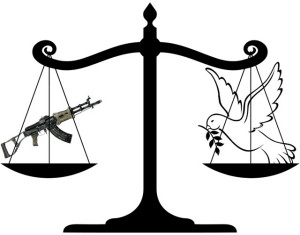 In my myriad discussions over the years, with friends and acquaintances who are dubious about the idea of Christian nonviolence, a recurring objection has been raised that often comes in a form much like this: “Yes, your theory is all well and good, but in the real world people are violent and evil, and can only be dealt with by force.” On the surface this objection seems to make a great deal of sense … after all, who can honestly say that the world wasn’t better off after Hitler was defeated (which is the usual example)? But I think that the example of World War II has perhaps enjoyed a little too much favor in this regard, and the more I observe history, the more I begin to wonder if perhaps that war (itself not nearly the clean case some would like to make it) may be a historical anomaly rather than the rule.
In my myriad discussions over the years, with friends and acquaintances who are dubious about the idea of Christian nonviolence, a recurring objection has been raised that often comes in a form much like this: “Yes, your theory is all well and good, but in the real world people are violent and evil, and can only be dealt with by force.” On the surface this objection seems to make a great deal of sense … after all, who can honestly say that the world wasn’t better off after Hitler was defeated (which is the usual example)? But I think that the example of World War II has perhaps enjoyed a little too much favor in this regard, and the more I observe history, the more I begin to wonder if perhaps that war (itself not nearly the clean case some would like to make it) may be a historical anomaly rather than the rule.
The objection to nonviolence is essentially theoretical. I say this for the simple reason that it has hardly ever been tried. People reject the notion of a nonviolent response to a Hitler or a Stalin or a Mao or a Saddam — or Hamas or ISIS or Israel — on the basis that they are (were) so violent/evil that they must be stopped. The failure of nonviolence is hypothetical, not historical. By contrast, if we only bother to look, history suggests pretty strongly that violence has a rather dismal track record. In no particular order, some examples:
- Israelis and Palestinians have been at each others’ throats for over seventy years. In this time neither the suicide attacks of the Palestinians, nor the massive–often disproportionate–military actions of the Israelis have been able to materially tip the balance. If anything, they have merely increased the rancor, added grudges, and hardened the perspective of each side. If any present conflict on earth calls into question the efficacy of violence, this one should, regardless of which side you think is in the right.
- The much-vaunted “victory” of the US in Iraq led to the disintegration of the country into sectarian and tribalistic factions that have been unable to come together and in fact are rapidly falling apart.
- Ten years of American action in Afghanistan resulted in a weak central government whose elected leaders couldn’t dispense with their own sectarian biases, and are now collapsing under the onslaught of the Islamic State of Iraq and Syria (ISIS), a group so extreme that even Al Quaeda and the Taliban consider them fringe.
- Very few historians dispute that the “War to End All Wars” laid the foundation for the rise of Hitler and the Second World War. What they acknowledge less frequently is that much of the partition of Africa and the Middle East that led to many present-day conflicts, also came out of WWI.
If anything, it seems to me that the critical lens ought to be focused, not on the theoretical futility of nonviolence, but on the repeated, demonstrated futility of armed intervention to solve nearly anything.
Now of course, from the perspective of a follower of Jesus, there is another vital point, and that is to say that “success” as defined by the world is never guaranteed. There are, in point of fact, things that a follower of Jesus may or must do, and others that she or he may not or must not do, and I believe that participating in the armed conflicts of this world falls into the latter camp. But that’s not really the point of this post; I’ve addressed that idea elsewhere (feel free to browse War & Peace on this blog for more).
The point for now is that even from a strictly-secular perspective, it seems to me that advocates of nonviolence need not assume the burden of proof their opponents often demand. While we don’t, in fact, know that nonviolence would work in any given situation, history provides a great deal of bloody evidence to suggest that violence is an abject failure. Next time anyone tells you that peace is impractical, ask how violence has worked out for them.
